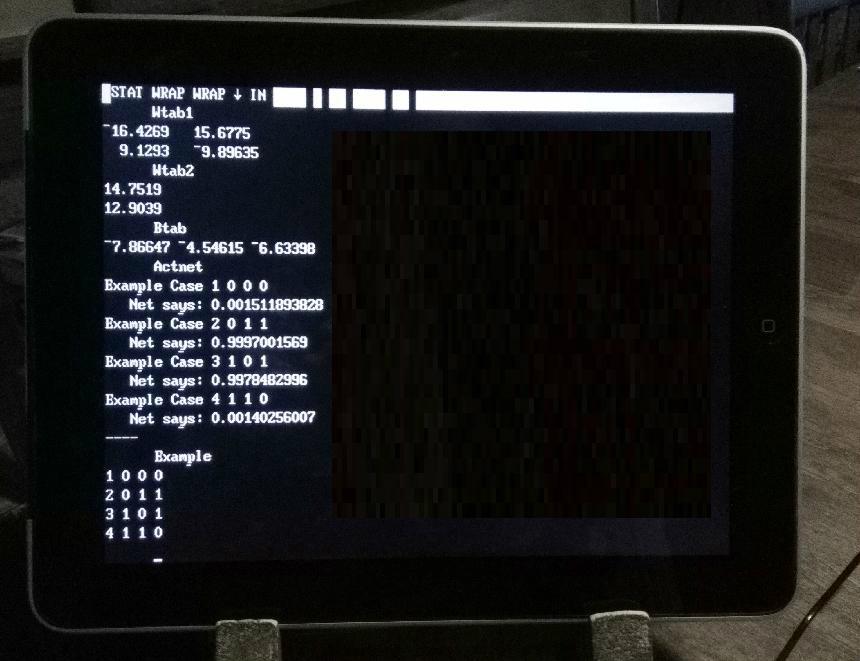Some TensorFlow Notes & Experiments
The TensorFlow Tutorial had a simple simulation program that generated images, using Laplace partial differential equation (PDE) math, and the initial program used IPython (interactive Python) and Python Notebook (which is now Jupyter Notebooks), to show a real-time simulation of rain-drops falling on a pond. I fiddled the damping parameter, the image display mechanism, and the background to create something that looks more like star formation via gravitational mass-accretion. This program verifies that Tensorflow has been installed successfully, and is doing its mathematics correctly. Oh, I also converted it from the TensorFlow 1.00 version (which I downloaded initially for the MacBook), to what is now TensorFlow 1.4.0, which has a more restrictive and explicit requirement to define a current session.
Built and tried Google's "Tensorflow", but it is very much oriented to images only.
It led to some interesting observations, but is complex, unwieldy, poorly documented, and really is almost entirely oriented to image-processing applications.
Just getting it to build from source, on our local machines, was a very major exercise. But we have not found it to be useful for numerical, market-related datasets.
Neural-Net on iPad - and GEMESYS Android/iPad sAPL
I've built a small sAPL workspace, as a proof-of-concept, that accepts the weights, bias values, and structure of a trivial Xor2 (boolean exclusive-or) neural network, trained using Xerion, which can be activated (ie. run), on the iPad. This has potential applications, as it would allow a complex network to be trained on a research machine, and then the network's weights and structure can be transfered to the iPad so that evolving, real-time scenarios can be entered on the fly, by someone who wants to query what the trained network's "thinks" of a possible data-scenario. It's a simple approach, but might be useful. An example of the simple Xor2 network being activated is shown here.
We have found value with small-scale neural networks. Here, we built a trivial network, which could then be executed on an iPad, to obtain results.
GEMESYS Android Apps - on GEMESYS GitHub Repository
gDOSbox has over 50,000 downloads on Google Play Store (Now, only available on GEMESYS github repository.)
The following GEMESYS Android Apps were available on the Google Play Store. They are now available from the GEMESYS Git Hub Site:
https://github.com/Gemesys/gemesys_repository/
gDOSbox - This is a full-featured implementation of the DOSbox-0.74 open-source DOS emulator for Android. It was developed for Android version 4 (KitKat series), and was recently upgraded to work on Android 5 series (and above) devices. Recent changes by Google to their keyboard have caused issues on some devices, so we strongly recommend the "Hacker's Keyboard", by Klaus Weidner.
Download "Hacker's Keyboard" from the Google Play Store, then use the Settings icon, scroll to "Language and Input", and select/invoke the "Hacker's Keyboard". Then, in the "Default Keyboard" option, choose the "Hacker's Keyboard" as your Default Keyboard. The Google keyboard attempts to hijack *all* user input, and damages the gDOSbox interface routines.
gDOSbox is a full DOS implementation, with corrected math routines, which allows DOS .exe files to be run on an Android tablet.
GNUplot37 - A version of the GNUplot graph generation tool. Allows data to be quickly plotted in two and three dimensions, as well as supporting math processing, and curve-fitting to data, and displaying the result. Try it with: "plot sin(x)" to see a sign wave. Then load the demo (hundreds of examples) with "load 'all.dem' ". To clear the screen, (if using an on-screen keyboard), use "!cls", and use "!dir /p" to review all the GNUplot examples available.
sAPL - The original IP Sharp 32-bit APL, which runs in an emulated IBM 360/75 environment as series of .exe files, orginally released to run on IBM P/C's, and them made into a freeware product by IP Sharp, to encourgage APL usage education. APL characters are generated by ALT-key (eg. ALT-L creates the APL quad character, ALT-[ creates the assignment operator, etc.), so the Hacker's Keyboard is required.
APLSE - The STSC APL freeware product, directly downloadable from the PlayStore. (You do not need to install gDOSbox, it is loaded first). This is an excellent small-footprint APL, which has full graphics support. It is reliable, and was released as a freeware product to encourage and assist APL education. Like sAPL, the APL characters are created using ALT sequences, so ALT-[, for example, is the assignment operator. The "Hacker's Keyboard" is required.
TryAPL2 - The IBM full featured "TryAPL2" product, which allows a subset of early APL2 to be run on a P/C. This is a working APL, which includes IBM's variant of the enclosed-array extensions. APL characters are generated with shift-letter sequences, so gKeyboard can be used with this APL.
WatAPL - The original Watcom APL, circa early 1980's. This was recovered of of an original Watcom APL System floppy diskette, and dates from 1984. It can be used with the gKeyboard, as the APL characters are generated with Shift-key sequences.
gKeyboard - A basic keyboard, with the APL characters shown on keytops. Useful for TryAPL2 and WatAPL, and for learning the location of APL characters on the keyboard.
All GEMESYS software is freeware for educational purposes, and contains *no* advertising or in-app usage monitoring or tracking.
************
I will put detailed instructions here about how to download and sideload these .APK files onto you ANDROID DEVICE:


